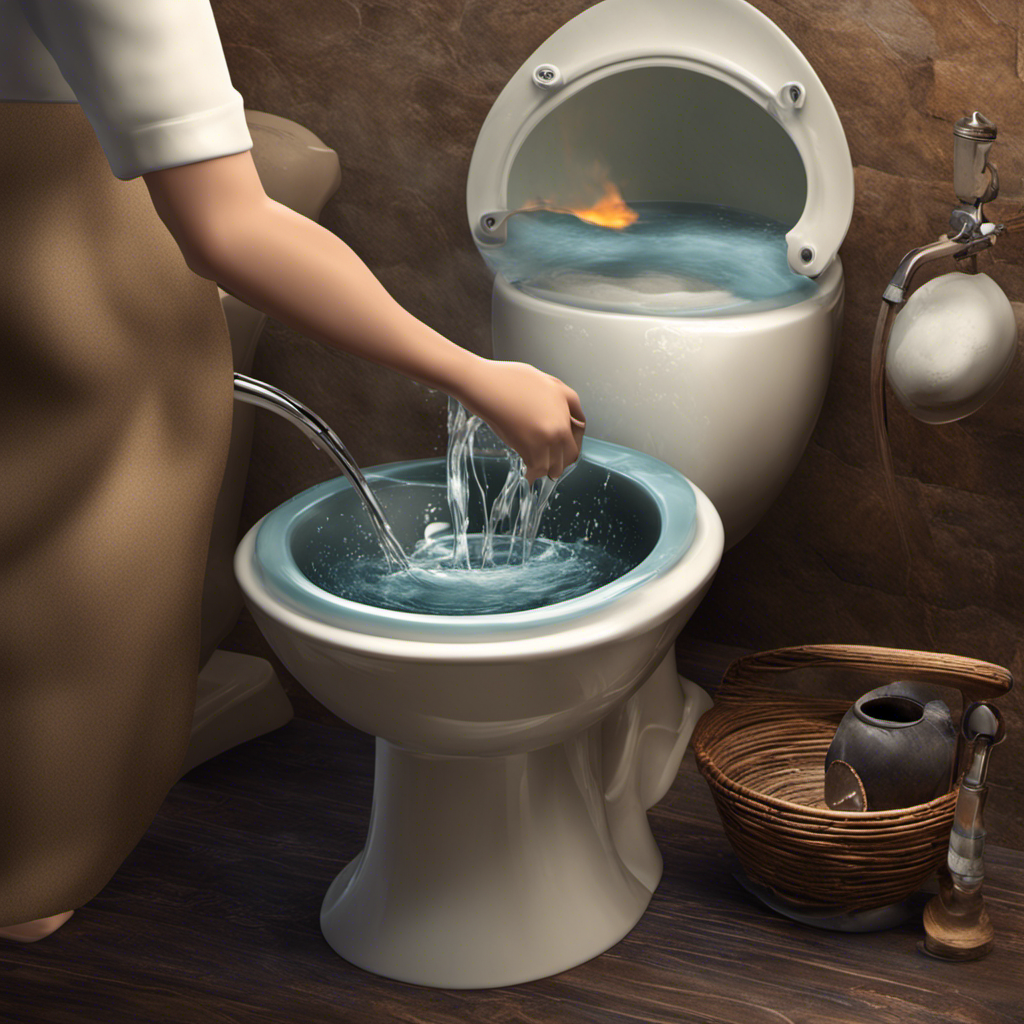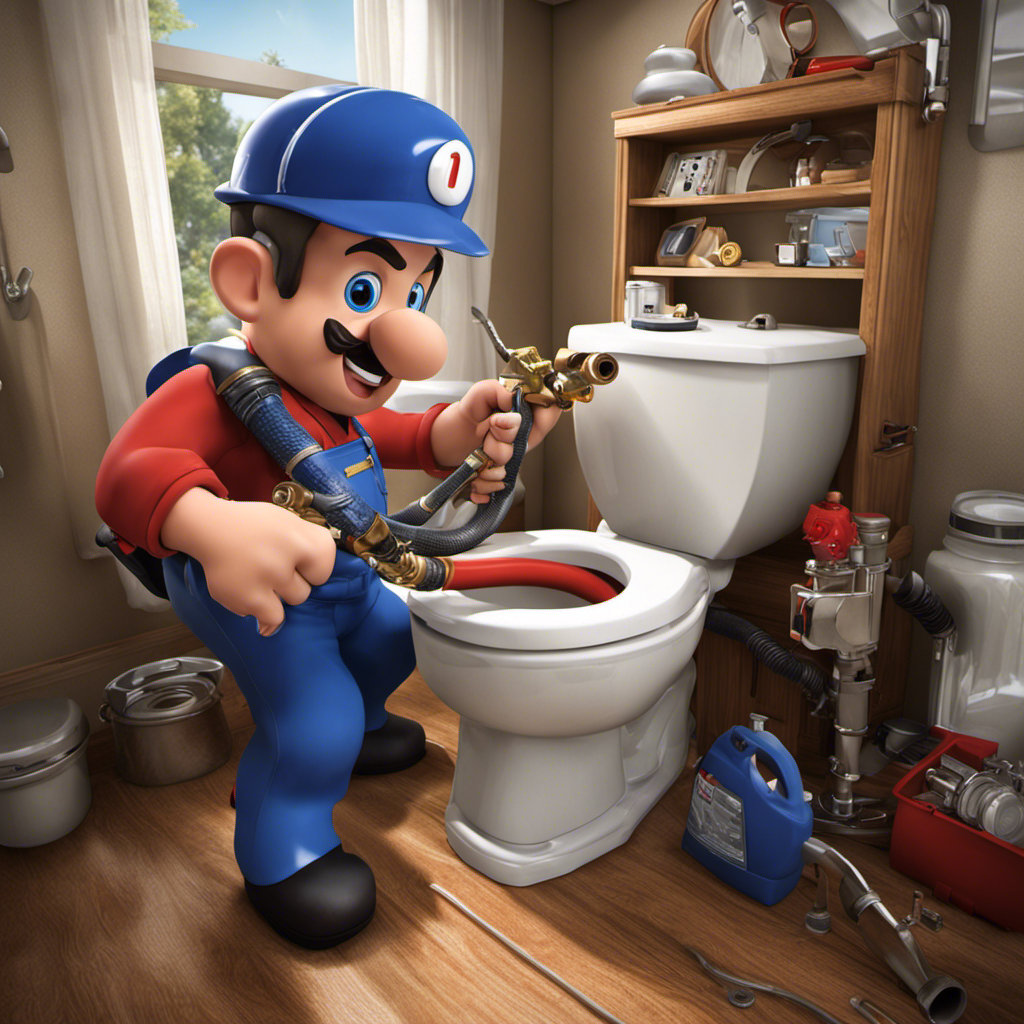So, you’re in a bit of a pickle with your clogged toilet, huh? Well, fear not! I’ve got just the solution for you – a trusty plumbing snake.
In this handy guide, I’ll walk you through the ins and outs of using a plumbing snake in your toilet. From choosing the right type of snake to avoiding common mistakes, I’ve got you covered.
So, let’s roll up our sleeves and get ready to tackle that stubborn clog head-on!
Key Takeaways
- There are two types of plumbing snakes for toilet use: manual snakes and electric snakes.
- Manual snakes are suitable for minor clogs and are affordable and easy to use.
- Electric snakes are more powerful and efficient but require skill to operate and can be more expensive.
- Proper snake handling is crucial to prevent mishaps or accidents, and precautions should be taken to protect the toilet from potential damage.
Types of Plumbing Snakes for Toilet Use
There are two main types of plumbing snakes for toilet use: manual and electric. Each type has its own advantages and considerations, so it’s important to choose the right one for your needs.
Manual snakes, also known as hand augers, are operated by hand and are suitable for minor clogs. They are affordable and easy to use, making them a popular choice for homeowners.
On the other hand, electric snakes, also known as power augers, are powered by an electric motor and are capable of tackling more stubborn clogs. They are faster and more efficient, but they can be more expensive and require some skill to operate.
When choosing the right type of snake for your toilet, consider the severity of the clog and your level of experience. Once you have determined the type of snake you need, you can move on to preparing the toilet for snake usage.
Preparing the Toilet for Snake Usage
When it comes to clearing blockages effectively, it’s important to understand the proper techniques and tools to use.
This not only ensures a successful outcome but also protects the toilet from potential damage.
Proper snake handling is crucial in this process, as it requires precision and care to avoid any mishaps or accidents.
Clearing Blockage Effectively
To clear the blockage effectively, you’ll want to make sure the plumbing snake is fully inserted into the toilet drain. This is a crucial step in resolving the clog and preventing future issues.
Start by positioning the snake at the entrance of the drain and slowly feed it in, being careful not to force it. Once inserted, rotate the snake clockwise to break up the obstruction. Applying gentle pressure will help the snake navigate through the pipes and dislodge the clog.
Continue rotating and pushing until you feel the snake move freely. If you encounter resistance, try retracting the snake slightly and then pushing it in again. This troubleshooting technique allows the snake to grab onto the blockage and pull it out.
Protecting Toilet From Damage
Make sure you’re careful when plunging the toilet to avoid causing any damage. Toilet protection is essential to prevent any harm to the porcelain, pipes, or other components of the toilet system.
To protect your toilet, start by using a plunger specifically designed for toilets. This will create a tight seal and generate enough pressure to dislodge the blockage without causing any harm. Avoid using excessive force or aggressive movements that could lead to cracks or leaks.
Additionally, be cautious when using chemical drain cleaners, as they can corrode the pipes and cause long-term damage. By taking these precautions, you can ensure that your toilet remains in good condition and prevent costly repairs.
Now, let’s move on to discussing proper snake handling techniques to effectively clear blockages.
Proper Snake Handling
Be careful not to exert too much force or move aggressively when handling the snake, as this can cause damage to the plumbing system.
Snake safety is of utmost importance when troubleshooting toilet clogs. When using a plumbing snake, it is essential to take the necessary precautions to prevent any mishaps.
Start by wearing protective gloves and safety glasses to shield yourself from any potential harm. Hold the snake firmly but not too tightly, ensuring proper control and maneuverability.
Gently insert the snake into the toilet bowl, avoiding any sudden jerks or twists. Slowly rotate the snake clockwise or counterclockwise while applying gentle pressure to dislodge the clog. Be patient and persistent, allowing the snake to do its job effectively.
Step-by-Step Guide to Using a Plumbing Snake in the Toilet
When it comes to using a plumbing snake in the toilet, there are three key points to keep in mind: proper snake insertion, effective clog removal, and preventing toilet damage.
To ensure successful unclogging, it is crucial to insert the snake properly into the toilet drain, making sure it reaches the clogged area.
Additionally, employing effective techniques for removing the clog is essential, such as rotating the snake clockwise while applying gentle pressure to dislodge the blockage.
Lastly, taking precautions to prevent toilet damage, such as avoiding excessive force or using the snake in other plumbing fixtures, is vital for maintaining the integrity of the toilet.
Proper Snake Insertion
To properly insert the plumbing snake into the toilet, you’ll want to ensure that you’re holding the handle firmly and positioning the snake’s tip at the opening of the drain. This will allow for effective clearing of any clogs or blockages.
Here are some key tips to keep in mind when inserting the snake into the toilet:
- Grip the handle firmly: This will give you better control and leverage when maneuvering the snake.
- Position the snake’s tip at the drain opening: Make sure the tip is inserted fully into the drain to reach the source of the clog.
- Rotate the snake clockwise: As you push the snake into the drain, rotate it in a clockwise direction to help break up the clog.
- Avoid excessive force: While it’s important to apply some pressure, avoid using excessive force as this can damage the pipes.
By following these steps, you can effectively use a plumbing snake to clear any toilet clogs or blockages.
Remember to practice regular snake maintenance and follow troubleshooting tips to ensure optimal performance.
Effective Clog Removal
Now that we have covered the proper insertion of a plumbing snake, let’s move on to the next step: effectively removing clogs. This is an essential skill for any homeowner or plumber.
Maintaining your snake is crucial for its optimal performance. After each use, clean the snake thoroughly with warm water and mild soap, removing any debris or residue. Additionally, ensure that the snake’s cable is straight and free from any bends or kinks.
Troubleshooting clog removal involves identifying the type of blockage and adjusting your technique accordingly. For soft clogs, gently push and twist the snake to break up the obstruction. For tougher clogs, apply more pressure while rotating the snake.
Remember to always work in a slow and steady motion to prevent any damage to your plumbing system.
Preventing Toilet Damage
Remember, it’s important to be mindful of what you flush down the toilet in order to prevent any potential damage. Proper toilet maintenance is key to avoiding costly repairs. Here are some crucial tips to ensure your toilet stays in good condition:
-
Avoid flushing non-flushable items: Only flush toilet paper and human waste down the toilet. Items like wipes, feminine hygiene products, and paper towels can clog the pipes and lead to damage.
-
Regularly clean the toilet: Use a non-abrasive cleaner and a toilet brush to remove any buildup or stains. This will prevent the accumulation of debris that can cause clogs.
-
Check for leaks: Periodically inspect the toilet for any signs of leaks, such as water pooling around the base or a constantly running toilet. Promptly addressing leaks can prevent further damage and water wastage.
-
Schedule professional inspections: Arrange for regular inspections by a professional plumber to identify and address any potential issues before they escalate into costly repairs.
Following these practices will help keep your toilet functioning properly and avoid the need for extensive toilet repair.
Tips and Tricks for Effective Snake Toilet Usage
For more efficient snake toilet usage, it’s important to start by inserting the snake slowly and steadily into the bowl. This ensures that the snake is properly positioned to effectively unclog the toilet. Once inserted, it’s crucial to rotate the snake clockwise while applying gentle pressure. This motion allows the snake to grab onto the clog and break it apart. If you encounter resistance, avoid forcing the snake as it may damage the toilet. Instead, try pulling back slightly and then pushing forward again. Repeat this process until the clog is cleared.
To help troubleshoot common toilet issues, refer to the following table:
| Toilet Issue | Possible Causes | Troubleshooting Tips |
|---|---|---|
| Weak Flush | Clogged drain or low water level | Use the snake to clear any obstructions or adjust the water level in the tank |
| Constantly Running Toilet | Faulty flapper or fill valve | Inspect and replace any faulty components |
| Toilet Leaking | Worn-out wax ring or loose connections | Replace the wax ring or tighten any loose connections |
Common Mistakes to Avoid When Using a Plumbing Snake in the Toilet
When using a plumbing snake in the toilet, it’s important to avoid forcing the tool if you encounter resistance. This can lead to further damage and make the situation worse. Instead, try these troubleshooting techniques to effectively use a plumbing snake in the toilet:
-
Ensure the snake is the correct length for your toilet. Using a snake that is too short or too long can make it difficult to reach the clog.
-
Use gentle and steady pressure when inserting the snake into the toilet. Pushing too hard can cause the snake to get stuck or damage the plumbing.
-
Rotate the snake in a clockwise motion while applying slight pressure. This helps the snake navigate through bends and break up the clog.
-
Pull the snake out slowly and carefully, making sure to clean off any debris that may have been dislodged.
Maintenance and Cleaning After Using a Plumbing Snake in the Toilet
To properly maintain and clean after using a plumbing snake in the toilet, don’t forget to sanitize the area and dispose of any debris.
After successfully unclogging the toilet using a plumbing snake, it is essential to clean and maintain the tools to ensure their longevity and effectiveness in future use.
Firstly, start by sanitizing the area around the toilet, including the handle of the snake and any surfaces that may have come into contact with the debris. Use a disinfectant cleaner and a clean cloth or paper towel for this task.
Next, carefully remove the debris from the snake. You can use a pair of disposable gloves to protect your hands during this process. Dispose of the debris properly, either by flushing it down the toilet or sealing it in a plastic bag and throwing it in the trash.
Lastly, clean and dry the snake thoroughly before storing it away. This will prevent any potential buildup of bacteria or odor.
Following these maintenance tips will help keep your plumbing snake in excellent working condition and promote a hygienic environment in your bathroom.
Frequently Asked Questions
Can I Use a Regular Drain Snake Instead of a Plumbing Snake for Toilet Use?
Using a regular drain snake for toilet use is not recommended. The pros include affordability and versatility, but the cons outweigh them. Plumbing snakes are specifically designed for toilets, ensuring better results and preventing damage to the toilet.
Is It Necessary to Remove the Toilet From the Floor Before Using a Plumbing Snake?
Removing the toilet from the floor is not necessary when using a plumbing snake. There are alternative methods that can be used to unclog a toilet without the need for removing the fixture.
How Far Should I Insert the Plumbing Snake Into the Toilet?
When using a plumbing snake in a toilet, it’s important to know how far to insert it. Proper technique involves gently pushing the snake into the toilet until you feel resistance, indicating a clog.
Can Using a Plumbing Snake Damage the Toilet Bowl or Pipes?
Using a toilet snake can potentially damage the toilet bowl or pipes if not used properly. To ensure safety and prevent damage, it’s important to follow the correct technique and avoid excessive force.
How Often Should I Clean and Maintain the Plumbing Snake After Using It in the Toilet?
After using the plumbing snake in the toilet, it is important to clean and maintain it regularly. I recommend cleaning it after each use and checking for any damage or wear. Regular maintenance will ensure its effectiveness and longevity.
Conclusion
After successfully using a plumbing snake in the toilet, I felt a sense of accomplishment and relief.
The snake’s powerful movements and precision allowed me to navigate through the labyrinth of pipes, clearing any obstacles in its path.
As I withdrew the snake, I could almost hear the echoes of a smoothly flowing toilet, no longer plagued by clogs and blockages.
With proper maintenance and regular cleaning, the plumbing snake will continue to be a trusted ally in my battle against toilet troubles.










